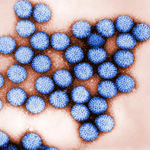Rotavirus Symptoms in Children
 Rotavirus infection is a very common infection in children and is a cause of severe diarrhea. Throughout the world, about 6, 00,000 children die each year due to this infection. The name is derived from the appearance of the virus when examined under a microscope. This virus has a wheel like appearance and as such is named rotavirus.
Rotavirus infection is a very common infection in children and is a cause of severe diarrhea. Throughout the world, about 6, 00,000 children die each year due to this infection. The name is derived from the appearance of the virus when examined under a microscope. This virus has a wheel like appearance and as such is named rotavirus.
By the time the child is three, in almost all cases he or she gets infected. Unlike most of the other viral infections, repeat infection from rotavirus is possible and in fact many children get infected again and again in the same year, mostly the first year of life. After repeated infections, the child develops immunity. In case of the adult getting infected, the illness is milder as compared to the children. This virus affects children throughout the world, including children in the developed world, as such it cannot be associated with sanitary conditions and water supply. It can occur at any time during the year.
Symptoms
When a child gets infected the symptoms start to appear within next two days. The main symptoms are fever, vomiting and watery diarrhoea which is reported several times in a day. The child also complains of pain in stomach. As is common with all viruses the child may develop cough and running nose. The infection takes three to nine days to be eradicated. In case of repeated infection the severity decreases.
Due to repeated passing of watery stool the child often gets dehydrated and severe dehydration without adequate measures is the cause of death. Thus it is essential to take proper care of this problem the moment its symptoms appear. In addition to the symptoms mentioned above the parents should be fully aware about the symptoms of dehydration. The child feels lethargy, the skin turns dry and cool, when the child cries there are no tears in his eyes. The eyes get sunken and the child is extremely thirsty.
The infection is contagious. It can pass on from a child to the other through by touch. When a child passes stool the virus could spread at the place where his nappy has been kept. In case another child touches the infected place and touches his mouth with his unwashed hands he is likely to get infected. This virus can survive for days on hard and dry surface and for hours on human hands. When the child starts to discharge watery stool steps should be taken for immediate replenishment of fluid in body. WHO suggested ORH solution should be administered. In serious case IV transfusion of fluid will be required.
Treatment
The existence of rotavirus can be diagnosed by examination of sample of stool of the child in the lab. Once it is ascertained that the child has got infected medical treatment should start without loss of time. The treatment is generally to prevent dehydration as rotavirus is self limiting disease that gets cured in three to nine days.
Vaccination
Being so prevalent it is difficult to prevent this virus spreading in a normal manner. Places with excellent hygienic conditions can get contaminated. As such it can be said that vaccination is the only preventive method which can be employed. Though vaccine is being used for quite some time but the earlier used vaccine was withdrawn in 1998 because of detection of its adverse effects and rotashield vaccine was withdrawn in 1999 because it was a cause of other serious problems in children.
Since 2006 a new vaccine RotaTea is being used to immunise children. It is administered to the child when he or she is 2 months, 4 months and 6 months of age. This vaccination has proved to be quite effective and acted as a preventive in about 74% of cases. This vaccine has reduced the incidents of hospitalisation in 98% of cases.